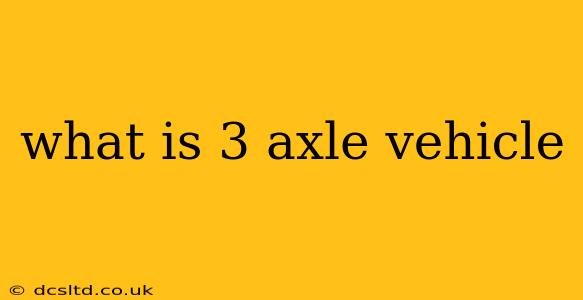What is a 3-Axle Vehicle?
A 3-axle vehicle is a motor vehicle supported by three axles, each with one or more wheels. This configuration offers several advantages in terms of weight capacity, stability, and maneuverability compared to vehicles with fewer axles. Let's delve deeper into the specifics.
What are the different types of 3-axle vehicles?
The types of 3-axle vehicles are diverse and depend heavily on their intended purpose. Some common examples include:
-
Heavy-duty trucks: These are frequently used for hauling large loads, such as construction materials, shipping containers, or oversized equipment. The extra axle allows for a significantly higher gross vehicle weight rating (GVWR) than a 2-axle truck. This is crucial for transporting heavy and bulky goods efficiently.
-
Buses: Larger passenger buses, particularly those designed for long-distance travel or carrying a high number of passengers, often utilize a three-axle configuration. The additional axle improves stability and helps distribute the weight of the passengers and luggage more evenly across the chassis.
-
Motorhomes (RVs): Some larger, luxury motorhomes employ a three-axle chassis to accommodate their substantial size and weight. This provides superior handling and stability, especially on uneven terrain.
-
Military vehicles: Certain military vehicles, such as heavy transport trucks or specialized armored personnel carriers, often utilize three axles for their increased payload capacity and ruggedness.
-
Specialized heavy equipment carriers: These vehicles are designed to transport heavy machinery and equipment, demanding a high load capacity and robust build. Three axles are frequently used to meet this need.
What are the advantages of a 3-axle vehicle?
The use of three axles provides several key advantages:
-
Increased weight capacity: The most significant advantage is the higher GVWR. Distributing the weight across three axles reduces stress on individual axles and tires, enabling the vehicle to carry heavier loads.
-
Improved stability: Three axles provide better stability, particularly when carrying heavy loads or navigating uneven terrain. The wider weight distribution enhances control and reduces the risk of tipping or rollover accidents.
-
Enhanced braking performance: The added axle allows for a more effective braking system. The larger contact area with the road surface contributes to shorter stopping distances.
-
Greater traction: In challenging conditions like snow or ice, the three axles offer enhanced traction. The increased contact area with the ground improves grip and reduces the likelihood of skidding.
How does the weight distribution work in a 3-axle vehicle?
Weight distribution in a 3-axle vehicle is crucial for optimal performance and safety. The exact distribution varies depending on the vehicle's design and the nature of the load being carried. However, the general principle is to distribute the weight evenly across all three axles to minimize stress and maximize stability. This is often achieved through careful placement of the load and the design of the vehicle's chassis.
What are the disadvantages of a 3-axle vehicle?
While offering substantial benefits, 3-axle vehicles also have some drawbacks:
-
Increased cost: Three-axle vehicles are typically more expensive to manufacture and maintain than their two-axle counterparts due to the additional components and complexity.
-
Reduced maneuverability: Their longer wheelbase can make them less maneuverable, especially in tight spaces or congested areas. Turning radii are generally larger.
-
Higher fuel consumption: The increased weight and complexity contribute to higher fuel consumption compared to vehicles with fewer axles.
-
More complex maintenance: Repair and maintenance can be more complex and costly due to the increased number of components.
In conclusion, a 3-axle vehicle is a valuable asset in situations requiring high weight capacity, stability, and traction. However, potential buyers should weigh these advantages against the higher cost and reduced maneuverability before making a purchase decision. The choice depends heavily on the specific application and operational requirements.
